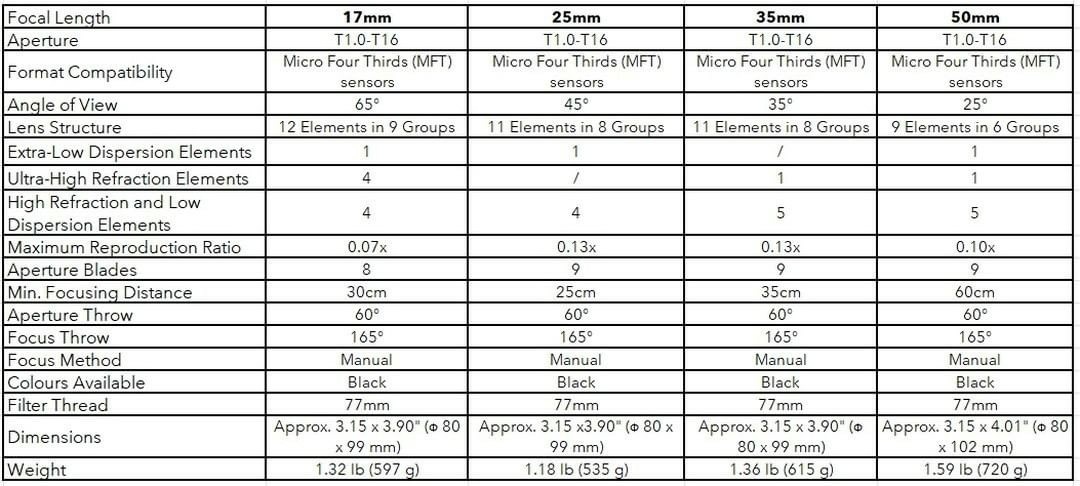Released today, I got my hands on the ultrafast Zhongyi Speedmaster 50mm T1.0 Cinematic Lens, and it surprised me how good it was.
This new lens joined the three other T/1 lenses they have in their Micro Four Thirds (MFT) stable: the 17mm, 25mm, and 35mm.
With ever more people switching to MFT for video, driven by the boom in short video reels on social media, there is a growing demand for cinematic lenses. Zhong Yi Optics has come up with a doozy.
If you are unaware of the T-stop on a lens, it is related to an f-stop but includes a measurement of the light transmitted through a lens. So, if you have a fast f/1.0 lens, the internal optics will decrease some of the light reaching the sensor. Therefore, it requires a wider aperture still to achieve the otherwise impossible zero loss through an f/1.0 lens. The T-Stop is the F-stop divided by the lens transmittance.
Most T1.0 lenses are f/0.95. Although not published in their data, I assume the widest aperture is around this.

It arrived protected in a smart, padded, stitched faux leather hard case. The lens feels like a quality-made piece of kit, reminiscent of the high-end pre-digital optics I had for my SLRs in the last century. It’s not a light lens, but one would not expect that with its solid, all-metal construction and large glass. On my scales, it weighed 700 g, although the official weight is 720 g (1.59 lbs). It is about 100 g (3.5 oz) more than my OM System Olympus OM-1 or a Panasonic Lumix G9. That notwithstanding, walking around using a shoulder strap didn’t feel cumbersome, and it was not unbalanced on a tripod.
The markings on the lens are a bright yellow, standing out against the black of its body. I was initially unsure about this until I tried shooting in low light. I was able to read the distance and aperture markings without having to reach either my torch or reading glasses.

Cinematic lenses don’t have stepped apertures like photographic lenses but a smooth transition across the aperture range. The lens is entirely manual, so they achieved the changing from T1 to the minimum aperture at T16 by turning the adjustment ring closest to the camera body. It takes less than a quarter turn to cover the entire aperture range. Similarly, the focus ring nearer the front of the lens travels from 2 feet (60 cm) to infinity in less than half a turn. That makes adjusting the lens fast and achievable in one small movement. That’s important for filmmakers wanting smooth and constant transitions.

The nonagon-shaped out-of-focus points of reflected sunlight on water.
The lens adjustments are firm, offering just the right amount of torque. That resistance is even across the entire length of travel for both the aperture and the focus, meaning one can easily find the correct adjustment without having to hunt back and forth for it. Using focus assistance in my camera was invaluable in helping me find the correct focal length.
The aperture comprises nine curved blades, so I anticipated this would give a nice look to the out-of-focus areas of a scene. Indeed, the results I got were very pleasing. The lens is capable of close-up shooting at just 60 cm (2 feet), and that proximity to the subject allows for an even shallower depth of field and pronounced out-of-focus areas in the photo. The maximum focusing distance is infinity.

At about 2 feet, and the aperture ajusted to T-1, the focus drop off is very fast, and the out-of-focus area is creamy and smooth. Click for larger version.
I took some still images using different settings for comparison purposes. All the photos are pleasingly and usably sharp, with minimal chromatic aberration visible on high-contrast edges in out-of-focus areas at some settings.
The following is a cropped photo shot at T1.0 (straight out of camera). You can detect some fringing in the first image, but nothing that wasn’t fixable in post-processing. The picture is also acceptably sharp.
When I reduced the aperture to T4.0, there was just the tiniest hint visible, and the image was scalpel sharp. At T8, there was no fringing.

Cropped image shot at f/8
At the smallest aperture, T16, there were still no purple or green edges, and there was a tiny increase in softness compared to T4.0 due to diffraction. Again, that is easily corrected in post-processing in video and still image editing software.
With MFT, 50mm gives an equivalent angle of view to a 100mm lens on a 35mm sensor camera; 25 degrees. For filming, that is a nice focal length for portraits and close-up shots. That is probably a narrower field of view than many people will use all the time, but because the aperture adjustments are in T-Stop, swapping with other lenses during a shoot enables you to maintain a constant light level.
This lens produces lens flare that will make JJ Abrams fans whoop. I pointed the camera directly into the sun in the following image to exaggerate the effect.

Shooting toward the sun but not including it in the shot gave a very pleasant, dreamy feel to the images, which would be great for soft portraits. Whether you want lens flare shooting contre-jour is a subjective choice. This amount of flare is usually seen on wide-angle lenses, but I have a 7-12mm f/2.8 lens that produces less lens flare than this. If it’s something you like, then the flare produced by this lens is attractive. If it’s something you avoid at all costs, you’ll be pointing this lens away from the sun when you use it.
It has a different lens structure from its predecessors, and the communications I received from Zhong Yi Optics suggest it performs better than their 17mm, 25mm, and 35mm T1 lenses. I don’t have these at hand, so I cannot put them to the test, but other reviews praise these lenses.
It is primarily a video lens, and I happily shot footage with it with super results. Nevertheless, being superfast, it also has low-light applications that might appeal to nighttime and astrophotographers.

Shot before dawn at ISO 200, T-1 and 6-seconds, it was actually too dark to see the cormorants roosting on the other side of the river. Click for larger view. The wood on the pier is slightly soft at this aperture, but not unacceptaby so.
What I Liked About This Lens and What Could Be Improved
This lens is a good product. It would be on my shopping list if I needed one. It’s well made, and the optics are clear and perform well; I’ve tried far worse lenses than this, including other super-fast T1.0 lenses and some consumer lenses on APS-C cameras.
Optically, I can see a difference when pixel-peeping when comparing my OM System M.Zuiko PRO lenses with this, but that is hardly surprising as those cost at least twice this lens. But it is as good as or better than many consumer-grade optics I’ve tried on other systems. Like most lenses, it performs best when stopped down a bit, but the image quality is perfectly acceptable when shooting wide open. It is at its sharpest between T4 and T11. Furthermore, that super-wide aperture enabled me to get footage and shots that would otherwise be unobtainable.
Its actions are smooth and easy to make, even with gloves on, with just the right amount of torque.
It is a fully manual lens, so there is no electronic communication with the camera. I reverted to jotting down the T-Stop settings on a piece of paper for these tests, something I usually only must do when shooting film. In most circumstances, this would be irrelevant. However, it might be necessary for those shooting longer videos with multiple lenses.
Getting manual focusing spot-on is not as easy with a lens sporting a very shallow depth of field, especially when shooting close-up to a subject, so I was grateful for the focus assistance tools in my camera.

The lens is both affordable and good value, at $399, which is the same price as the 17 mm, 25 mm, and 35 mm T1 lenses. Those lenses are currently available as a bundle and this lens will be added to that imminently. The new full bundle including the new 50mm retails at $1,339.









